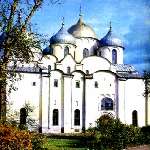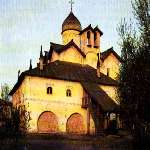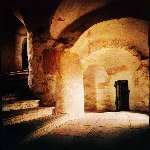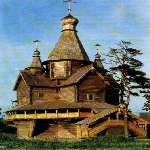Veliky Novgorod is situated in the north-west of the European part of Russia, 180 kilometres away from Petersburg and 606 kilometres away from Moscow.
* Veliky Novgorod is a chance to learn the authentic history of Russia, ill provided with written sources. Here the history appears as a visual ensemble of material monuments - from domestic antiquities, found annually during archaeological excavations, to monumental architectural buildings of all centuries starting from the 10th century.
 |
 |
 |
 |
 |
 |
 |
* Definition of the date of foundation of the town was based on the chronicles, but, according to some of them, the Novgorodians already existed in 854, according to the others, in 859. The second date was accepted as a starting point and in 1959 the 1100th anniversary of the town was celebrated.
There is no other town in Russia except Novgorod that has played such an important role in the history of our statehood at early stages of its development.
In the first centuries of history of our state Novgorod was the main support of strong prince's power in Russia. In Novgorod Rurik's clan had originated and gradually forced out all other Russian prince families in numerous princedoms of Russia. Prince Oleg accomplished his campaign against Kiev in 882. He seized Kiev and consolidated the two largest unions of eastern Slavonic tribes:
the Ilmen Slavs and the Polans. As a result a new strong state - Kievan Rus - was formed in the East of Europe.
The Novgorodian chronicles, started in 1077, are the oldest in Russia. The most ancient monument of Russian juridical life "Russkaya Pravda" appeared in Novgorod.
The oldest stone medieval castle in Russia - the Kremlin - is also situated in Novgorod.
Political and public system of the Novgorodian princedom in the 11th century had much in common with other Russian princedoms. Prince's power was strong just like in Kiev. Princes owned the land, appointed and removed officials, administered justice and meted out punishment.
Development of Novgorod had outstripped many other towns of Western Europe. Novgorod gained independence and became the richest boyar republic with the enormous land areas from the Finnish Galf to the Urals and the Middle Volga.
Since the 12th century till the liquidation of the republican rules at the end of the 15th century Novgorod region was the largest state formation in the medieval Europe. Its territory could have contained several European countries. Novgorod was a town with good amenities. Its roadways are 200 years older then roadways in Paris and 500 years older than in London.
In the 12th century there were already water supply and sewerage system in Novgorod. Executive power was performed by the Boyar Council headed by the richest landowner.
The Council was an actual ruler of the town, only in exclusive cases controlled by the Veche. That time princes were not sent from Kiev, but were invited by the Veche as military specialists. According to a special agreement, they had limited rights.
* Commodity circulation in the ancient Novgorod had no equal. The town was a stronghold of business undertakings. It was a member of Ganza (the trade union of the North-European cities).
* The Mongol-Tartar invasion in the 13th century did not strike Novgorod the way it did the towns of Vladimir-Suzdal and Ryazan regions and the South-Russian towns of the Podneprovie.
* D.S. Likhachev, "� Novgorod had escaped the defeat and preserved Russian culture for Russia; during the expansion the Novgorodians had defended their independence, their national cultural look. At the dawn of Russian history we are much obliged to the Novgorodians that we exist the way we are, that we are the Russians."
Since the middle of the 15th century Novgorod had lost its position and Moscow began to play the leading role. Moscow prince Ivan III had consolidated Novgorod to Moscow State.
As a symbol of his victory, in January 15, 1478, he removed the Novgorodian Veche bell to Moscow. Since that moment in history of Novgorod the period connected with development of Moscow State had began. Despite the loss of independence, at the beginning of the 16th century Novgorod still remained the biggest centre of Russian trade, workcraft and small-scale commodity production.
The rich town was constantly causing somebody's envy. At the end of 1569 the case of the Novgorodian treason had been forged that caused a campaign against Novgorod.
Tsar Ivan the Terrible punished the "plotters" severely and, naturally, took away all the values including the property of plundered monasteries from Novgorod to Moscow. The richest families of Novgorod were killed. At the beginning of the 17th century the country was struck with famine.
Hardships were aggravated with the Polish- Swedish intervention in 1604-1617. In 1611 Novgorod was seized by the Swedish Army. It was occupied until 1617. The Swedes completed what the Russian tsars Ivan III and Ivan IV had begun. Veliky Novgorod could not recover the strokes.
Industrial development of the town in the 18th century was extremely weak. Because of shift of working resources and loss of trade independence many professions disappeared and the rich town market fell into decay.
In the 19th century Novgorod that had been playing a great role in the history of our Motherland in the Middle Ages turned into an out-of-the-way town of the Russian Empire.
In December 14, 1992 at the jubilee conference of the World Heritage Committee UNESCO it was decided to include the historical monuments of Novgorod and its suburbs into the List of World Heritage.
Novgorod became a member of International Union "The New Ganza Time". 206 towns and 16 countries were included in the number of participants.
In 1998 by the decree of the President of Russia the ancient name - Veliky Novgorod - was given back to the town.
We wish you a pleasant tour about Veliky Novgorod.
 Orthodoxy in Veliky Novgorod: history and modern situation
Orthodoxy in Veliky Novgorod: history and modern situation
The Novgorodian eparchy is one of the most ancient Russian eparchies with history dating back to more than 1000 years. It was distinguished not only by its enormous territory. Numerous cathedrals were being built, monasteries were being founded, many of which are still visited by pilgrims. There the wonder-making icons of the Virgin, such as of Tikhvin, of Znamen, of St. Sophia, became famous. There are relics of the whole assembly of saints. More than 100 of them are included into the Novgorodian Synod of Saints, many of them have got national celebration.
* The ancient Novgorodian pantheon was surpassing the pantheon of other Russian lands. 17 archbishops from 30 heading the Novgorodian chair till 1478 were canonized.
St.
Sophia Cathedral inVeliky
Novgorod
The first 9 (since 992 till 1165) were bishops of Novgorod, since 1165 till 1589 - archbishops of Novgorod and Pskov, since 1598 till 1721 - metropolitan of Novgorod the Great, Velikie Luki and Pomorie.
* In 1775 the Novgorodian and St. Petersburg eparchies were united. The new eparchy was headed by the archbishop of Novgorod and St. Petersburg. In 1783 the archbishop was elevated to metropolitan, since 1892 till 1933 - archbishop of Novgorod and Staraya Russa, since 1933 till 1955 and since 1967 till 1990 - metropolitans of Leningrad and Novgorod.
* In 1990 Lev, the bishop of Novgorod and Staraya Russa, became the head of the eparchy. In 1995 he was elevated to archbishop.
* The history of the Novgorodian eparchy is inseparable from the history of Novgorod that by the end of the 11th century became one of the powerful centres of Russia. In the beginning it did not differ from other episcopal chairs of Russia. It was dependent on the Kievan metropolitan who was admitting the bishops.
* But starting from 1157 (till 1478) bishops were elected by the Novgorodian Veche and ordained by the metropolitan. More than that - since 1165 the Novgorodian bishops had a holy order of archbishop that indicated their high position; all the other eparchies were headed by bishops.
* The Novgorodian bishops possessed canonical and state power. According to canon laws that were determined by the Greek nomocanon, Russian church rules and regulations, the bishops taught, elevated to orders, consecrated churches, ruled the clergy and monasteries, and also as the main keeper of the Orthodoxy in Novgorod hampered dissemination of heresy, preached belief in Christ and guarded church schools. They controlled morals not only of the clergy but also of the laymen. Thus, they could judge family quarrels and property arguments. They also were in charge of all the trade measures and scales.
* The state side of the bishops' activities was as follows. They took part in all the negotiations of Russian princes and ambassadors of foreign states. After the bishops' interference disturbances and revolts ceased. The bishops had their own regiment and could bless either beginning of war or making peace.
* The richest treasury of the Novgorodian bishops, kept in the gallery of St. Sophia Cathedral, was used at war times, to conclude peaceful treaties, to ransom captives, etc. It was also used for different social activities (building of the Kremlin stone walls, bridges, etc.), for building of cathedrals, to give help during different calamities (floods, fires, plagues, droughts).
* The church was a social - religious centre of the Novgorodians. Under its walls Veche meetings were being gathered, officials were being elected, different problems were being solved. In the centre of all activities there was a parish priest. The community was choosing a priest and a clergy of a parish itself. By 1478 in Novgorod there were 82 churches not taking into account suburban monasteries.
* In spite of the loss of independence in the end of the 15th century, the Novgorodian chair preserved its special position as well as the head of the chair. He was the only one among other bishops who wore a white klobuk (headgear of Orthodox monk).
* In the 17th century the Novgorodian Church underwent terrible events. The Swedes destroyed all the sacred places, monasteries and churches.
The Novgorodian metropolitans are following traditions of their predecessors. They are not only rebuilding churches and monasteries but also erecting and founding new ones.
* By the end of the 19th century in the Novgorodian eparchy there were nearly 1000 churches: among them - 700 parish ones, 32 male and female monasteries.
* The Novgorodian bishops have always paid special attention to charity. They were giving food for the poor, arranging hospitals, alms-houses, orphanages. Another direction of their activity was education. There appeared a Greek - Slavonic - Latin school at the Bishop's House (1706), a seminary (1740), theological schools in many towns and later villages of the eparchy.